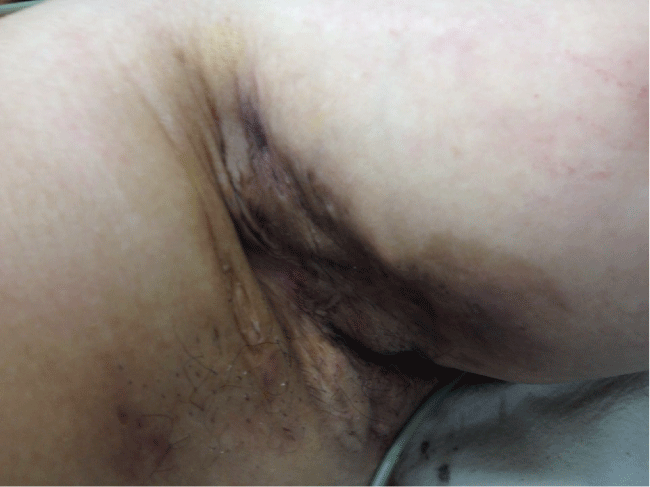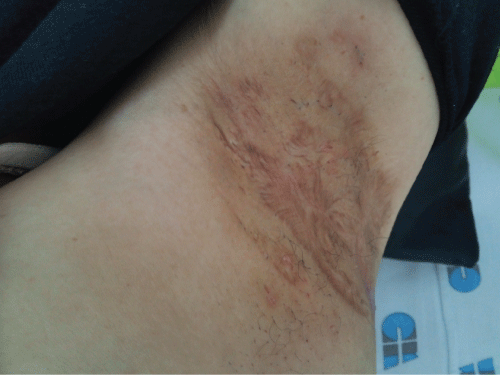Journal of Dermatology Research and Therapy
Rapid Improvement of Hidradenitis Suppurativa Following Sleeve Gastrectomy
Jong-Seob Park, Ji-Sun Hong and Sang-Moon Han*
Department of Surgery, Gangnam CHA Medical Center, CHA University, Korea
*Corresponding author:
Sang-Moon Han, MD, PhD, Department of Surgery, Gangnam CHA Medical Center, School of Medicine, CHA University, 566 Nonhyun-ro, Gangnam-Gu, Seoul 06135, Korea, Tel: 02-3468-3369, Fax: 02-3468-3507, E-mail: surgeryhan@gmail.com
J Dermatol Res Ther, JDRT-2-012, (Volume 2, Issue 1), Case Report; ISSN: 2469-5750
Received: November 12, 2015 | Accepted: January 13, 2016 | Published: January 16, 2016
Citation: Jong-Seob P, Ji-Sun H, Sang-Moon H (2016) Rapid Improvement of Hidradenitis Suppurativa Following Sleeve Gastrectomy. J Dermatol Res Ther 2:012. 10.23937/2469-5750/1510012
Copyright: © 2016 Jong-Seob P, et al. This is an open-access article distributed under the terms of the Creative Commons Attribution License, which permits unrestricted use, distribution, and reproduction in any medium, provided the original author and source are credited.
Abstract
Severe obesity is commonly associated with dermatologic disorders such as intertrigo, psoriasis and hidradenitis suppurativa (HS). HS is a chronic inflammatory skin disease characterized by clusters of nodules, cysts, and abscesses that commonly affects hair bearing areas such as axilla, groin and perianal regions. Treatments of HS are complicated and vary depending on presentation and severity of the disease. We report here, the case of a 36-year-old female who showed rapid improvement of long-standing treatment-refractory HS following laparoscopic sleeve gastrectomy and subsequent weight loss. This severely obese patient had previously shown little response to multiple treatment modalities, including antibiotic therapies, isotretinoin, and surgical removal of abscess. Rapid improvement of lymphedema and abscess at axilla areas was observed during 12 months postoperatively. Weight loss may be of value in the treatment of HS, and bariatric surgery may be considered in cases of complicated HS with morbid obesity.
Keywords
Morbid obesity, Hidradenitis suppurativa, Sleeve gastrectomy
Introduction
Hidradenitis Suppuratativa (HS) is a chronic disorder of the terminal follicular epithelium in the apocrine sweat gland bearing areas such as axilla, groin and perianal regions [1]. This condition is characterized by comedo-like follicular occlusion, chronic inflammation, papules, nodules, tunnels, and progressive scarring [1,2]. HS is more common in obese people and cigarette smokers [3-5]. Obesity and smoking are not direct causes. However, they can be regarded as risk factors. Medical treatment of HS is difficult, and it is sometimes refractory to medical treatment. Therefore, weight loss and stopping smoking are required for medical treatment of HS. In general, long-standing HS usually requires surgery. The surgical procedures including laser treatment and wide excision chosen depend on the severity or extent of HS. However, the prognosis is variable. Treatment-refractory HS can disrupt working and activities as well as causes psychological and sexual relationship difficulties [6]. In this case study, we report on a patient with long-standing treatment-refractory HS, which showed rapid improvement following laparoscopic sleeve gastrectomy (LSG) with dramatic weight loss.
Case Report
A 36-year-old female presented to our out-patient clinic with a history of axillary pain and recurrent abscess with severe obesity. The patient had been diagnosed with HS 20 years earlier, at the age of 16 years. After puberty, the patient had undergone medical treatments including antibiotics and isotretinoin (Roaccutane) for several years. However, the grade or extents of HS were not improved. Therefore, the patient had undergone several surgical treatments including excision and drainage for 20 years. Nevertheless, the patient experienced recurrent episodes of foul odor and pus discharge. Quality of life was markedly reduced by discomfort and unpleasant discharge of pus from an axillary abscess. Height and weight were 153 cm and 76.3 kg and body mass index (BMI) was 32.6 kg/m2. The patient had hypertension and dyslipidemia with obesity. On physical examination, there was evidence of active HS with follicular papules and nodules affecting the axilla (Figure 1). In spite of repeat treatments including antibiotics, isotretinoin and surgical excision of abscesses, HS was not improved. Therefore, the patient was referred by a dermatologist due to failure of medical treatment. Weight loss was considered the only solution to end the vicious cycle. The patient provided informed consent regarding LSG, and underwent LSG in April 2014. LSG was performed as previously described by Han et al. [7]. A 36-French bougie was used for resection, and a continuous seromuscular suture at the resection margin was performed. A point on the greater curvature approximately 4 cm proximal to the pylorus was identified as the distal extent of the resection. In the postoperative period, weight was 58.2 kg with BMI of 24.9 kg/m2 in July 2014. Three months after LSG, foul odor and pus discharge at axilla had ceased and no new abscesses appeared. The patient did not take antibiotics or isotretinoin during this period. Twelve months later (April 2015), weight was 56 kg with a BMI of 23.9 kg/m2, the patient had lost a total of 20.3 kg. After LSG, HS remained quiescent during a follow-up period of 1 year (Figure 2). The patient did not take any medications for HS after LSG. A regular follow-up laboratory test was performed 12 months later. Results showed that the level of total protein and albumin was normal; iron, calcium and magnesium remained within normal limits postoperatively; folate and vitamin B12 showed no deficiency. The patient no longer complains of foul odor and discharge from the axilla.

.
Figure 1: Preoperative picture showing comedo-like follicular occlusion, mucopurulent discharge, and numous scaring at left axilla.
View Figure 1

.
Figure 2: Appearance on axilla after laparoscopic sleeve gastrectomy at 1 year postoperatively.
View Figure 2
Discussion
In general, dermatologists recommend smoking cessation and weight loss to lessen HS associated with obesity. Obesity increases skin-on-skin folds, leading to follicular hyperkeratinization and occlusion via desquamation. The moist environment of the skin folds may allow bacteria to thrive and to colonize the affected sites. Obesity is a clear risk factor for HS [3,4]. HS increases the risk for development of other health problems, including heart disease and diabetes and also increases the risk of having a stroke [8]. Therefore, losing weight has additional benefits for people with HS. Kromann et al. [4] reported that the number of patients reporting HS symptoms after weight loss surgery decreased by 35% and the mean number of involved sites was reduced from 1.93 to 1.22 (p = 0.003) following weight loss. From a severity of HS perspective, a weight loss of more than 15% is associated with a significant reduction of disease severity. When HS progress into the skin, medical treatment alone may not be effective. Most dermatologists may recommend a surgical procedure such as laser surgery, deroofing, drain or incision and excision under these circumstances. HS often does not respond to a surgical procedure, i.e. complicated or refractory HS. Thomas et al. [9] reported 1 case of rapid resolution of refractory HS after LSG. In this case report, they mentioned that weight loss may be important in treatment of HS, with a dramatic reduction in disease activity occurring after weight loss. In our case, she had received medical treatments including antibiotics and acitretin for several years but the activity of HS was not improved. The weight loss procedure does not directly affect treatment of HS; however her HS activity showed rapid improvement after LSG. Three months later, foul odor and pus discharge at axilla ceased and no new abscesses appeared. She did not take medications during postoperative 1 year and was very satisfied with significant weight loss and resolution.
LSG is currently the most frequently performed procedure for weight loss in USA/Canada and in the Asia/Pacific regions, and second to Roux-en Y gastric bypass in Europe [10]. LSG is the first choice for treatment of obesity with lower BMI (30-35 kg/m2) in our clinic [11]. In this case of refractory HS with severe obesity, losing weight following bariatric surgery may be an effective treatment option. Therefore, bariatric surgeons should not hesitate to perform a bariatric procedure for treatment of complicated or refractory HS with severe obesity. Furthermore, diet and lifestyle change should have accompanied after LSG.
References
-
Jemec GB (2012) Clinical practice. Hidradenitis suppurativa. N Engl J Med 366: 158-164.
-
Slade DE, Powell BW, Mortimer PS (2003) Hidradenitis suppurativa: pathogenesis and management. Br J Plast Surg 56: 451-461.
-
Revuz JE, Canoui-Poitrine F, Wolkenstein P, Viallette C, Gabison G, et al. (2008) Prevalence and factors associated with hidradenitis suppurativa: results from two case-control studies. J Am Acad Dermatol 59: 596-601.
-
Kromann CB, Ibler KS, Kristiansen VB, Jemec GB (2014) The influence of body weight on the prevalence and severity of hidradenitis suppurativa. Acta Derm Venereol 94: 553-557.
-
Sartorius K, Emtestam L, Jemec GB, Lapins J (2009) Objective scoring of hidradenitis suppurativa reflecting the role of tobacco smoking and obesity. Br J Dermatol 161: 831-839.
-
Matusiak A, Bieniek A, Szepietowski JC (2010) Hidradenitis suppurativa markedly decreases quality of life and professional activity. J Am Acad Dermatol 62: 706-708.
-
Moon Han S, Kim WW, Oh JH (2005) Results of laparoscopic sleeve gastrectomy (LSG) at 1 year in morbidly obese Korean patients. Obes Surg 15: 1469-1475.
-
Shalom G, Freud T, Harman-Boehm I, Polishchuk I, Cohen AD (2015) Hidradenitis suppurativa and metabolic syndrome: a comparative cross-sectional study of 3207 patients. Br J Dermatol 173: 464-470.
-
Thomas CL, Gordon KD, Mortimer PS (2014) Rapid resolution of hidradenitis suppurativa after bariatric surgical intervention. Clin Exp Dermatol 39: 315-317.
-
Angrisani L, Santonicola A, Iovino P, Formisano G, Buchwald H, et al. (2015) Bariatric Surgery Worldwide 2013. Obes Surg 25: 1822-1832.
-
Hong JS, Kim WW, Han SM (2015) Five-year results of laparoscopic sleeve gastrectomy in Korean patients with lower body mass index (30-35 kg/m2). Obes Surg 25: 824-829.





